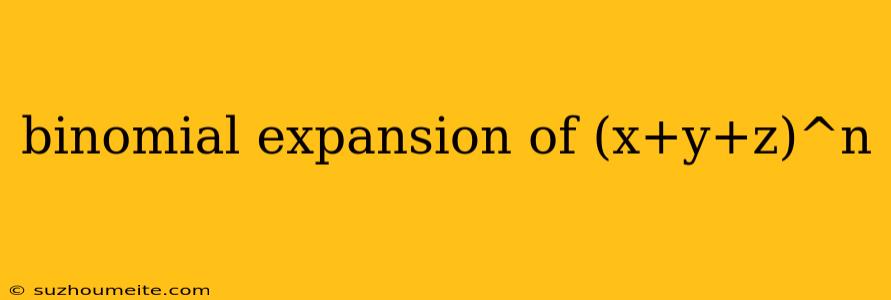Binomial Expansion of (x+y+z)^n
The binomial theorem provides a formula for expanding expressions of the form (x + y)^n. However, when we have a trinomial like (x + y + z)^n, the binomial theorem doesn't directly apply.
Here's how we can expand (x + y + z)^n:
Understanding the Concept
The key is to treat the trinomial as a binomial by grouping two terms together. Let's group (y + z) together:
(x + y + z)^n = (x + (y + z))^n
Now, we can apply the binomial theorem:
(x + (y + z))^n = ∑_(k=0)^n (n choose k) x^(n-k) (y + z)^k
where (n choose k) = n! / (k! * (n-k)!).
Next, we expand the term (y + z)^k using the binomial theorem again:
(y + z)^k = ∑_(j=0)^k (k choose j) y^(k-j) z^j
Finally, substituting this back into the original equation, we get:
(x + y + z)^n = ∑(k=0)^n ∑(j=0)^k (n choose k) (k choose j) x^(n-k) y^(k-j) z^j
Example
Let's expand (x + y + z)^3 using this formula:
(x + y + z)^3 = ∑(k=0)^3 ∑(j=0)^k (3 choose k) (k choose j) x^(3-k) y^(k-j) z^j
- k = 0: (3 choose 0) (0 choose 0) x^3 = x^3
- k = 1:
- j = 0: (3 choose 1) (1 choose 0) x^2 y = 3x^2y
- j = 1: (3 choose 1) (1 choose 1) x^2 z = 3x^2z
- k = 2:
- j = 0: (3 choose 2) (2 choose 0) xy^2 = 3xy^2
- j = 1: (3 choose 2) (2 choose 1) xyz = 6xyz
- j = 2: (3 choose 2) (2 choose 2) xz^2 = 3xz^2
- k = 3:
- j = 0: (3 choose 3) (3 choose 0) y^3 = y^3
- j = 1: (3 choose 3) (3 choose 1) y^2z = 3y^2z
- j = 2: (3 choose 3) (3 choose 2) yz^2 = 3yz^2
- j = 3: (3 choose 3) (3 choose 3) z^3 = z^3
Adding all these terms together, we get:
(x + y + z)^3 = x^3 + 3x^2y + 3x^2z + 3xy^2 + 6xyz + 3xz^2 + y^3 + 3y^2z + 3yz^2 + z^3
Conclusion
The formula we derived provides a systematic way to expand trinomials to any power. The process involves nested summation and repeated application of the binomial theorem. While the calculations can be tedious, understanding the concept and the steps involved is crucial for applying the expansion in various mathematical contexts.
